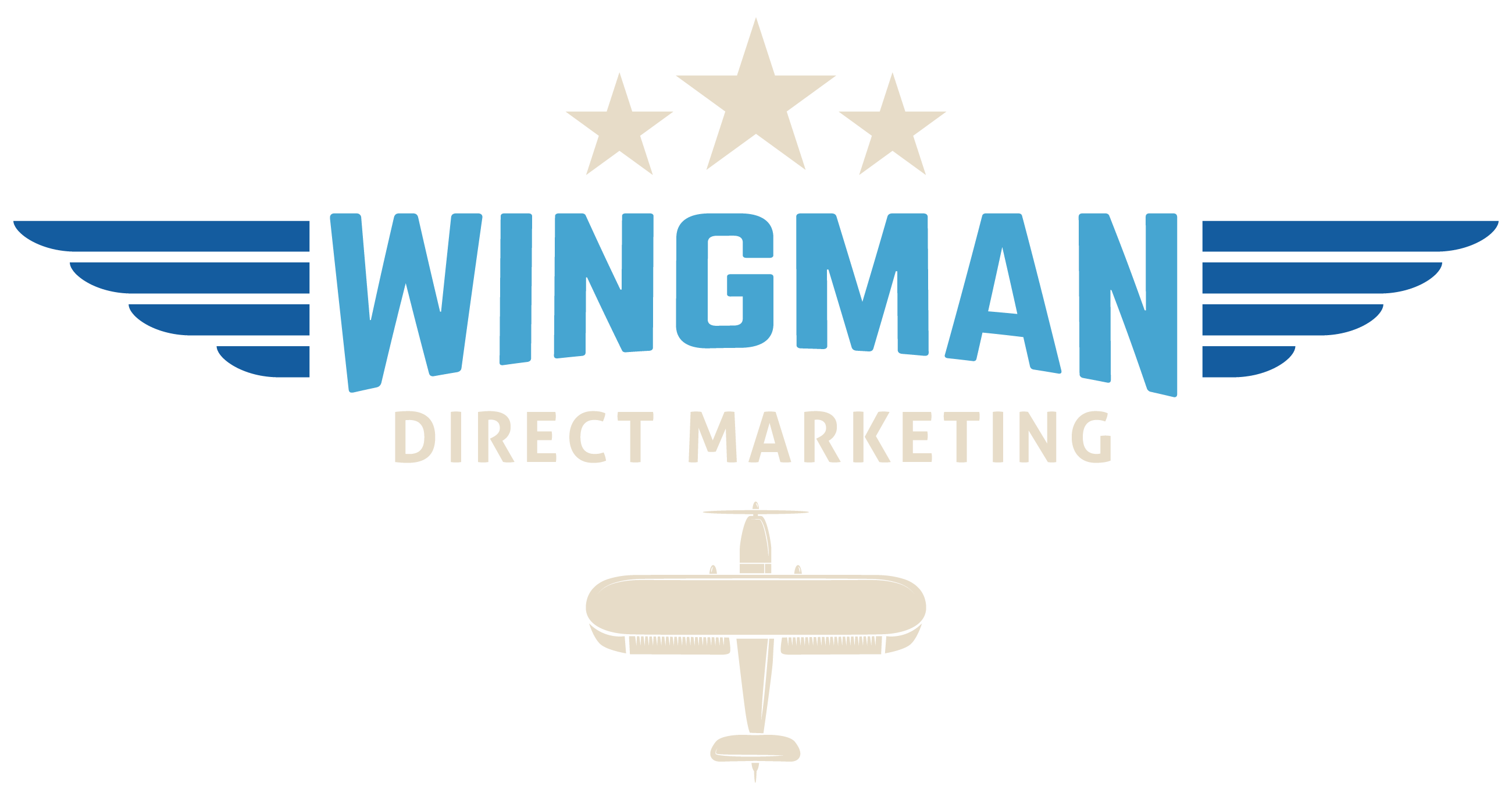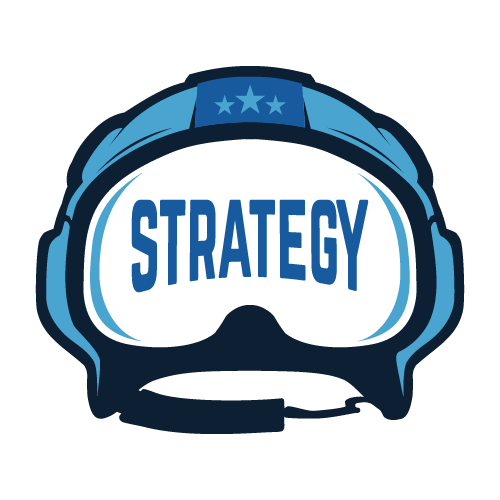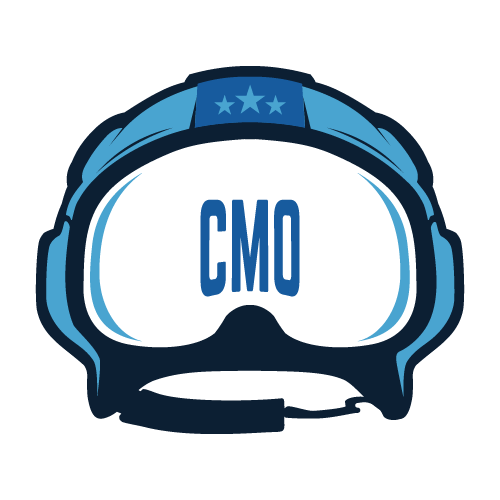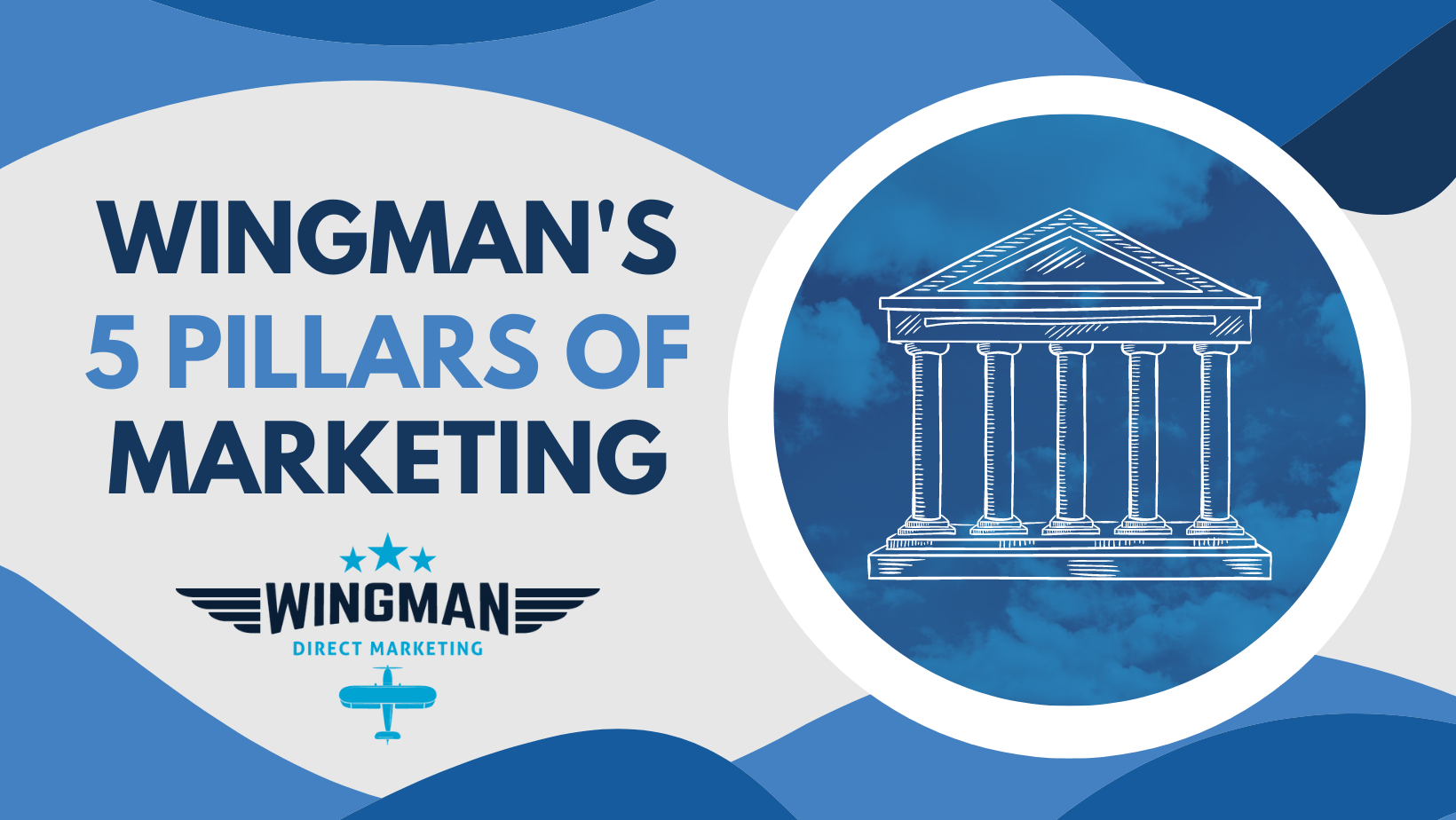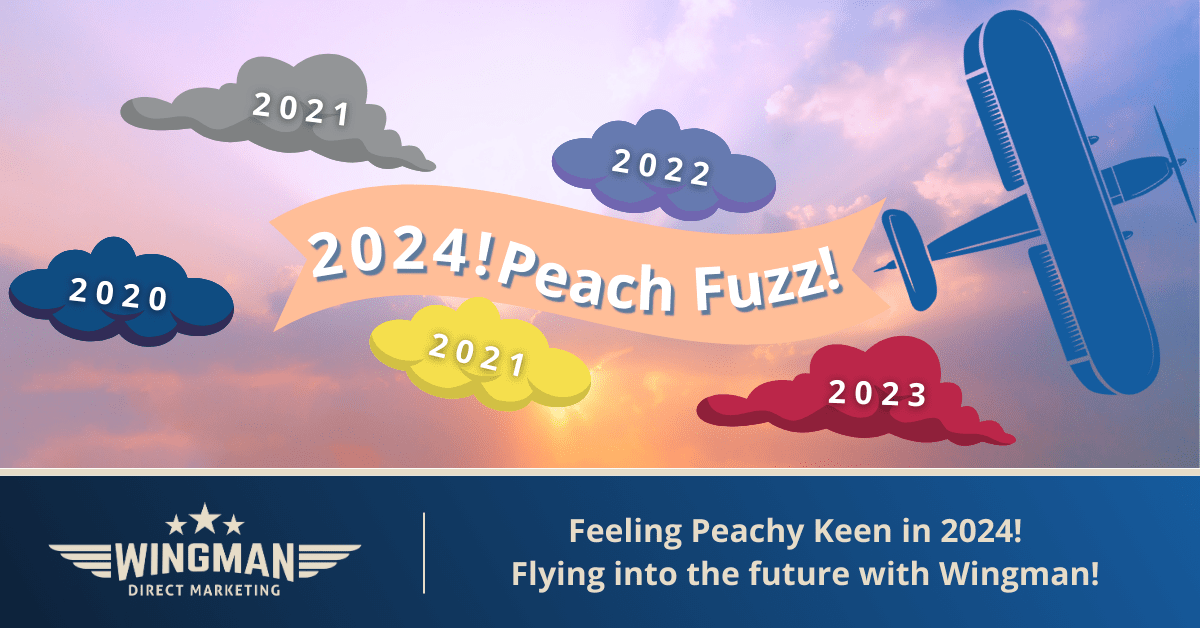What are Wingman’s 5 Pillars of Marketing? You’ve heard of Jerome McCarthy’s managerial approach to marketing – the 4-P’s. Product, Place, Price and Promotion make up the Marketing Mix students have been studying since the late 1950’s. Product solves a problem, price defines the value, promotion allows you to talk about it and place makes it available for a satisfactory transaction.
These four brothers of marketing alliteration have been hanging around marketing textbooks since the mid-50’s. In the last couple of decades, they have even had more profoundly prominent pioneers of promotional prowess siblings come along. They call themselves Process, Physical Environment and People. That is one crazy busy dinner table!
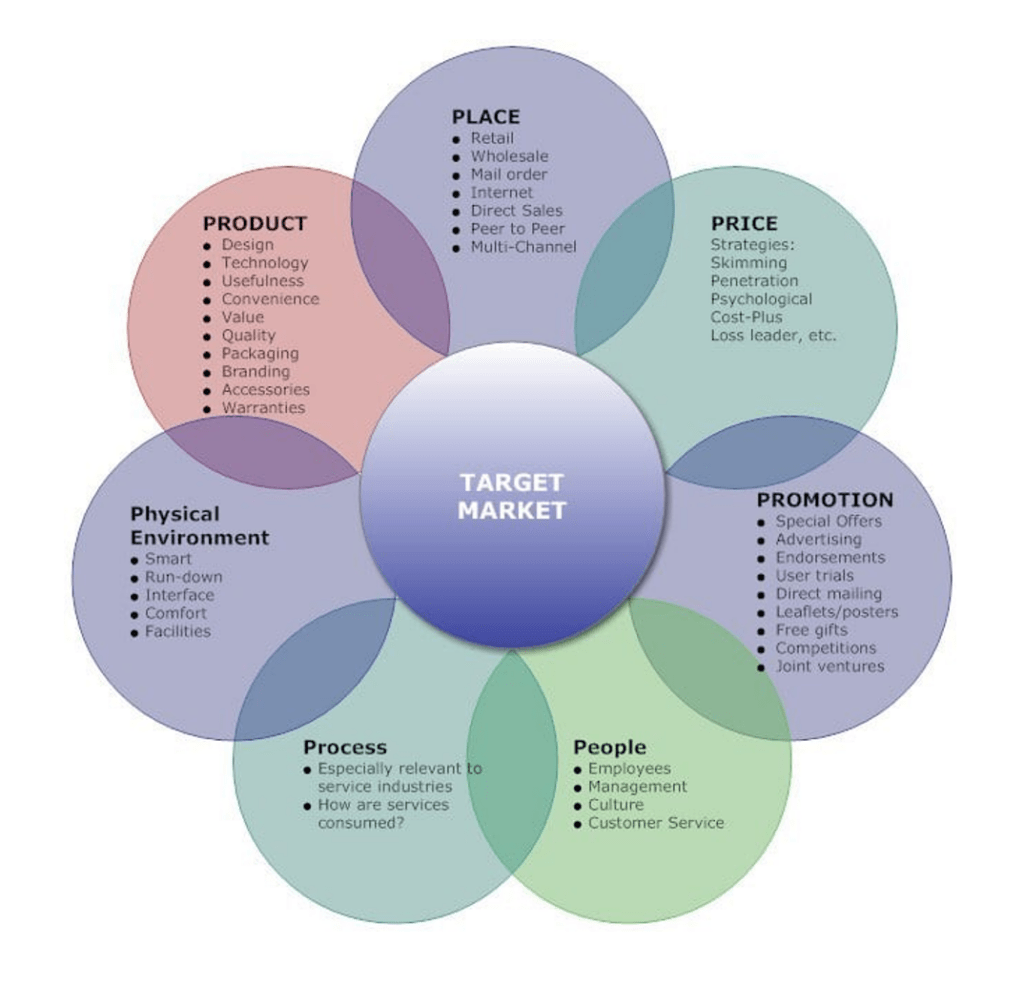
Well, at Wingman Direct Marketing & Digital Advisory, we prefer to look at the Marketing Mix as Wingman’s 5 Pillars of Marketing, which includes:
- Direct Marketing
- Digital Marketing
- Design Marketing
- Data-Driven Marketing
- Dialogue Marketing
Our 5 D’s or 5 Pillars of Marketing cover what we say for our clients, how we say it, who we say it to, when we say it, where we say it and why we say it (if you’re counting at home, that is 6, but we couldn’t come up with another witty D word).
5 Pillars of Marketing – Direct Marketing
Our namesake and the backbone of our 5 pillars of marketing.
It is Wingman’s belief that all marketing should be direct. Direct marketing clinically can be defined as a form of marketing or promotion that specifically targets a person or company to generate new business, raise the profile of an organization or product or to make a sale. Direct mail, direct response, telemarketing and email marketing are all popular tactics of direct marketing.
A well-strategized direct marketing campaign can put your message directly in the hands of your ideal customers. To be successful at direct marketing, your communication needs three things. Wingman calls these three things the three-legged stool. The stool needs:
- An intriguing offer and content to solve a specific problem or problems
- A target audience hand-picked with a likelihood or propensity to need their problem(s) solved with your solution
- A creative vessel, package or medium that attracts that audience to your solution.
Weighting priority lies heaviest on your chosen audience (List = 70%). If you are promoting your services to people who ultimately don’t care, you have invested good money on absolutely nothing. Similarly, if you have targeted correctly but your message (Offer = 20%) misses the mark, your message goes nowhere. And, pulling up the rear, if your direct marketing initiative is unappealing or eye-grabbing (Creative = 10%), it too will have limited to no success. Regardless of the weighting, it is after all a three-legged stool.
List (Target Market), Offer (Pricing and Value Proposition) and Creative (Layout and Branding) are the three legs of the Marketing “stool.” Working together in tandem results in solid and sturdy marketing. Remove or produce inadequately any of the three legs and the stool tumbles to the ground.
Related blogs:
7 WAYS DIRECT MAIL MARKETING CAN BE A SILVER BULLET FOR YOUR BUSINESS
ARE YOU LEVERAGING DIRECT MAIL IN YOUR MARKETING HOURGLASS?
DOES YOUR EMAIL MARKETING CAMPAIGN SCORE 5 OUT OF 5 FOR CONTENT?
40-YEAR-OLD TRACTORS AND DIRECT MAIL GET USED BECAUSE THEY WORK
WHICH DIRECT MAIL SERVICE OPTION IS BEST FOR YOU?
6 REASONS TO OUTSOURCE YOUR DIRECT MARKETING TO WINGMAN DIRECT
5 Pillars of Marketing – Digital Marketing
At Wingman, we use digital marketing synonymously with the term Total Online Presence (or TOP Gun for fun). There are dozens of moving parts involved in digital marketing and the online elements increase in importance with each passing day. But marketing is a system and to effectively operate this system you must assemble and integrate each of the important parts into something that looks like the whole. Thus, our use of the term ‘Total.’
Your online presence is your key to success no matter what your business sells – no matter if all your transactions are done face-to-face – no matter if you don’t yet see a way to get a return from your Facebook page – no matter if you’ve never bought an online ad. The key, however, is to build a Total Online Presence, like how you would build a tall, sturdy building, by constructing floor by floor in specific order or in stages. Your stages may differ just a bit based on where you are today and you’ll surely come back and revisit, add on to and revamp each stage as you grow.
We at Wingman believe the below 7-part model is the surest way to view your online marketing as a system. But before you get to these 7 digital marketing tactics, at the foundation, you need a website that converts visitors into customers. This is at the center of your Total Online Presence.
Your website is THE key tactic at the heart of all Wingman’s 5 pillars of marketing
No matter what your business sells today your website is the hub of your marketing. It must be able to tell your story and guide your prospects to take the actions that turn them into customers. There are key elements that every small business website must have. To help you build a website that drives growth Wingman will:
- Design a site structure and flow that engages visitors (designing the website straddles the line with Design Marketing below)
- Create and feature your core message to help you stand out
- Feature your ideal customers to help prospects know they are in the right place
- Build the content for your core web pages and SEO plan
- Add case studies, accomplishments, and testimonials that help build trust
- Tell the full story of your products, services, and mission
- Integrate video content for trust-building and engagement
- Audit, organize, and refresh your existing content
Now, onto the 7 tactics of a Total Online Presence:
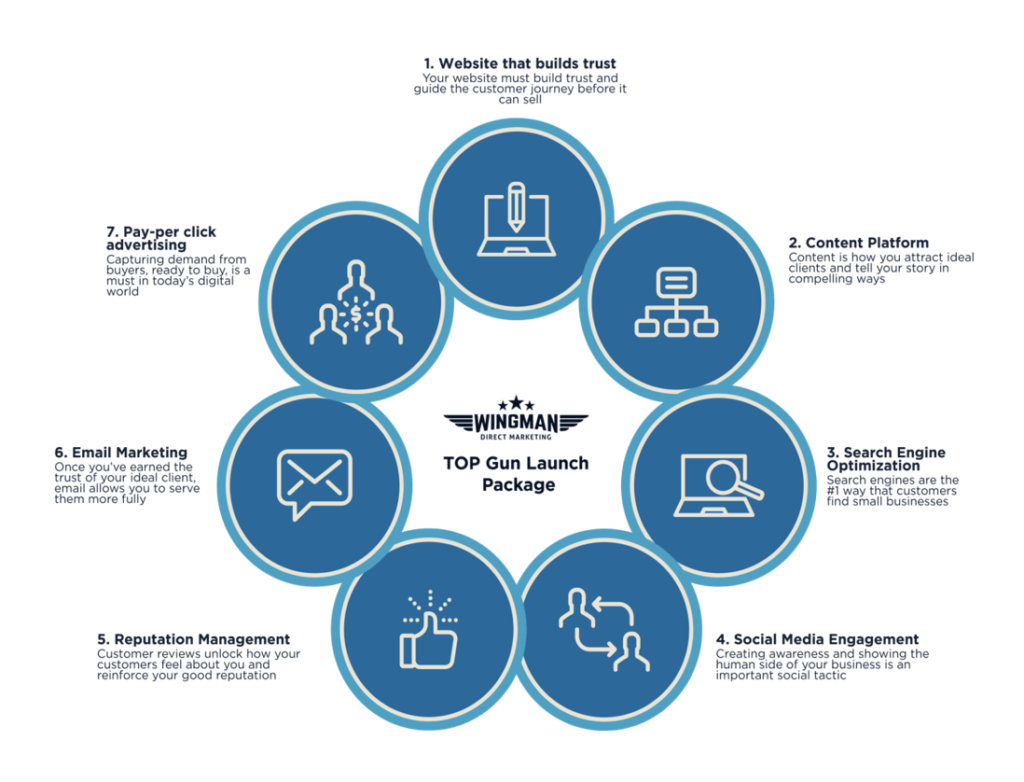
- Content Platform (see Dialogue Marketing below). So much of what happens online revolves around content. It’s how you get found, why people pay attention and how you start to exchange value. Without a content platform to build from a great deal of effort in other stages will be wasted.
- Organic SEO. Being found at the exact moment a prospect needs your product or service is the most important aspect of digital marketing. This is the ultimate payoff and long-term, may be the difference between success and failure. Search Engine Optimization can be complex and time consuming. It is also always changing. With that said, most businesses can generate remarkable results without making it difficult. Focus on the following three elements to simply rank
- Produce keyword rich content
- Make it easy for search engines to find you (use THEIR best practices)
- Link to and get linked from other sites naturally and seemingly organically.
- Email & SMS Marketing. While sharing much of the same DNA as direct mail, email and SMS have the digital advantages of instantaneous click-ability and reporting. Your unique and engaged email list can be your most valuable digital asset. 1000 responsive email followers trump 25,000 Twitter followers every day when it comes to promoting the things that make you money. Focus on building a list of email subscribers that want to hear from you and social media will become a tool set to help you do more of that.
- Social Media Marketing. This is certainly an area where you should consider strategy before tactics. The first step is to understand how your current customers are using social media and how you can use social media to somehow serve them better. If you do that, you’ll get immediate value.
- Online Advertising. Many people waste advertising and then conclude it doesn’t work. Pay per click advertising can be amazingly effective when done right. The best part of online advertising such as Google Ads or Facebook Ads is the fact you can evaluate your thinking a dollar at a time. An industry best practice is to use your ads to drive content awareness instead of simply to sell.
- Online Reputation Management. Online reviews and online reputation management are invaluable for consumers who have never tried your product or service and want to know others’ honest experiences with your business. A 2021 survey indicated that 98% of consumers read online reviews for local businesses.
An online review reflects a past or current customer’s experience with your organization’s products or services. Reviews can be posted on sites such as Google Reviews, Yelp, and Facebook. Testimonials can also be especially important but are different than reviews as they are found on your business’s website. Testimonials are valuable but arguably not as valuable as reviews due to their tendency to always be positive.
- Analytics & Conversion. As you build out your digital marketing tactics and campaigns, make certain you install mechanisms (tracking code from tools such as Google Analytics), so you can begin to build the data to assess and refine from. Then you can start building conversion goals, funnels and events, tracking your ads and split testing your landing pages, opt-in pages and sales pages to discover ways to increase conversion.
Related blogs:
WHAT EXACTLY IS DIGITAL MARKETING?
7 TWITTER BIO IDEAS TO CONVERT VISITORS INTO FOLLOWERS
11 ELEMENTS OF A WEBSITE LANDING PAGE THAT WILL INCREASE WEBSITE CONVERSIONS
5 DIGITAL MARKETING MISTAKES TO AVOID IN 2022
SIX REASONS WHY WRITING A REGULAR BLOG IS IMPERATIVE IN 2021
TOP 8 DIGITAL MARKETING QUESTIONS WINGMAN TEAM GETS ASKED
SEVEN LINKEDIN MYTHS STOPPING YOUR GROWTH DEBUNKED
5 Pillars of Marketing – Design Marketing
Design Marketing starts with branding but doesn’t end there. It encompasses your consistent use of colours, fonts, imagery, logos, choice of tone, and so much more. Your advertising, marketing, promotions, invoice layout, job postings all need to be designed with your consistent branding in mind.
A company’s brand (notice we use the word ‘brand’ here; not ‘branding’) is single-handedly the most important asset to a company, despite its intangibility.
At WMDM, we know every interaction—clients, vendors, fellow employees, prospects—is a transaction in your brand bank account and the opportunities to make an impact lie in each of these interactions. A successful brand is not a logo or a slogan or a foosball table in the staff lounge. You do not own your brand. It belongs in the collective perception of your business. It requires a strong belief in yourself and what you’re capable of, consistency and follow-through and is transparent so any falseness will be observed and gauged accordingly.
Through collaboration, when a plan of action is consistently applied, your brand will grow and over time will take on a life of its own.
Design of your branding on the other hand is fully within your control. At Wingman, we can assist you with Brand Development & Design, Website Design, Print Collateral / Out of Home, Typeface Development, Logo Design, Graphic Design and Microsite / Hub page / Landing Page Development.
Related blogs:
11 ELEMENTS OF A WEBSITE LANDING PAGE THAT WILL INCREASE WEBSITE CONVERSIONS
WINGMAN DIRECT MARKETING CREATIVE PROCESS
WHAT DOES YOUR BRANDING SAY ABOUT YOUR BUSINESS?
THREE EASY WAYS TO STAY ON BRAND
ONE SIZE DOES NOT FIT ALL: RESPONSIVE DESIGN
LET’S TALK COLOUR – WHAT’S THE DIFFERENCE BETWEEN RGB, CMYK, HEX AND PMS? (PART 1)
LET’S TALK COLOUR – DESIGNING FOR ONLINE AND OFFLINE MEDIUMS (PART 2)
5 Pillars of Marketing – Data-Driven Marketing
Data-driven marketing allows you to connect with your customers at the right time with the right message in the right medium. The benefits of using the data go beyond just improving your communications. Modern marketing teams use customer insights to:
- Personalise the customer experience
- Target well-defined marketing segments
- Get new customers
- Measure and improve strategies in real time
In its simplest form, big data helps marketers make better decisions that deliver greater results and do it faster. And it works. You can benefit from your data in other ways too. For example:
- Gain better clarity about the target audience. All information about your customers allows you to gain laser-sharp understanding of your target audience. Insights from your CRM, for example, can increase a marketer’s ability to predict customer behaviour further. The result? Campaigns that ultimately will reach your customers with the right message at the right time.
- Data offers the ability to build stronger connections with potential customers. With data, marketers can build better connections with their audience. What’s more, they can do so at a scale too. You have a near-infinite combination of media, devices, platforms and channels. Harvested correctly, you can deliver 1-to-1 customer experiences at a massive scale.
- Uncover the best channels for promotion. Data can reveal not only your target audience’s preferences but what channels to use. This kind of insight can position your message where your target audience is or is going to be soon.
- Personalisation. Today’s customers can see through your non-personalized marketing messages. Your data can deliver a holistic view of your target audience. It helps identify potential customers’ triggers and pain points delivering as much as 5x to 8x ROI for your marketing campaigns.
Related blogs:
HOW LONG DOES IT TAKE TO GET WEBSITE TRAFFIC?
4 TIPS TO OPTIMIZE YOUR WRITTEN CONTENT FOR VOICE SEARCH
SEM 101 PART 1: KEYWORD, CPC, CTR, AND MORE
SEM 101 (PART 2): HOW DOES QUALITY SCORE WORK IN SEM?
SEM 101 PART 3: BRANDED AND HIGH-INTENT KEYWORD CAMPAIGNS
SEM 101 PART 4: LOW-INTENT AND COMPETITOR KEYWORD CAMPAIGNS
5 Pillars of Marketing – Dialogue Marketing
Content marketing or dialogue marketing is perfect for establishing your business as your industry’s subject matter expert. You can nurture prospects at the top of your sales funnel and develop value for your clients.
But dialogue marketing without a strategy is like using a megaphone in the middle of the street—you’re just making noise. Content marketing is a top-of-funnel marketing strategy where building relevant, appealing and timely content is at the forefront of potential clients, requiring patience and consistency for efforts to bear fruit. And while results of the efforts aren’t felt immediately, it cements your company as the subject matter experts in your field. Credibility is established. Trust is earned.
Of course, while developing content plays a crucial role in any content marketing strategy, it is much more than simply articles, company updates and business trends—you’re not a publication. What separates content marketing from content development is that content marketing requires a well-thought-out strategy behind it—and all great content marketing strategies require a singular, clearly defined, measurable goal: driving profitable client action.
Unfortunately, this is where businesses can falter. Many businesses understand what they get out of writing content—reap SEO benefits, prospects see whether the company has a pulse, and it fills their website with “stuff”—but many of them don’t understand what the reader gets out of it, resulting in posts that receive zero traffic and wasting time or other valuable resources. Before even thinking of asking your prospects to open their wallets, what insights can you offer your readers in exchange for their time, let alone their money?
It is important to position your company as the thought leaders of your industry, establish credibility and trust with prospects, and develop relationships first before asking them to do business with you. By doing so, you fill the top of your sales funnel with qualified leads that are easier to convert. If your company has valuable insight or resources that your client would be interested in, content marketing is the perfect solution.
Most companies suck at the ability to communicate value for their product or service. Ultimately, communicating your value allows you to express your authority and ability to help your audience. It allows you to build trust and to draw their attention to the solutions to their problems. They may even become aware of problems they did not know they had – problems for which you have solutions.
To communicate value is to gently lead your audience along on an enjoyable and respectful journey. A journey where they get to trust you and value your knowledge and expertise. Do so by:
- Being their Wingman
- Revving their Engine.
- Demonstrate Before and After
- Do not bury the Lead.
- Show Them. Do not Tell Them.
Related blogs:
5 BIG REASONS WHY YOU NEED A SOCIAL MEDIA CONTENT CALENDAR
4 TIPS TO OPTIMIZE YOUR WRITTEN CONTENT FOR VOICE SEARCH
DOES YOUR EMAIL MARKETING CAMPAIGN SCORE 5 OUT OF 5 FOR CONTENT?
COPY VS. CONTENT: FISH WRAP VS. FISH FOOD
WHY ONLINE REVIEWS ARE ESSENTIAL FOR YOUR BUSINESS
11 WAYS TO COMMUNICATE VALUE IN YOUR MARKETING
Conclusion
Our 5 D’s or 5 Pillars of Marketing cover what we say for our clients, how we say it, who we say it to, when we say it, where we say it and why we say it (if you’re counting at home, that is 6, but we couldn’t come up with another witty D word).
Book a Wingman today!
